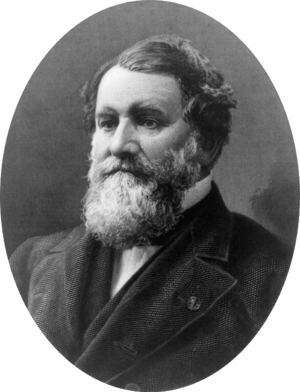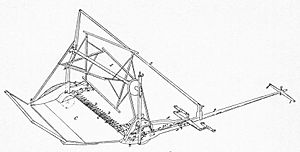Cyrus McCormick facts for kids
Quick facts for kids
Cyrus McCormick
|
|
|---|---|
 |
|
| Born |
Cyrus Hall McCormick
February 15, 1809 Raphine, Virginia, U.S.
|
| Died | May 13, 1884 (aged 75) Chicago, Illinois, U.S.
|
| Resting place | Graceland Cemetery |
| Occupation | inventor and agricultural machinery tycoon |
| Known for | Founder of the McCormick Harvesting Machine Company Co-designer of the mechanical reaper |
| Spouse(s) | Nancy Fowler (m. 1858–1884; his death) |
| Children | 7 |
| Parent(s) | Robert McCormick Jr. Mary Ann Hall |
| Relatives | See McCormick family |
| Signature | |
Cyrus Hall McCormick (born February 15, 1809 – died May 13, 1884) was an American inventor and a smart businessman. He started the McCormick Harvesting Machine Company. This company later joined with others to form the International Harvester Company in 1902. Cyrus McCormick was from Virginia, but he and his family became well-known in Chicago.
Many people think Cyrus McCormick invented the mechanical reaper all by himself. But he was actually one of several engineers who made successful reapers in the 1830s. His work built on more than 20 years of effort by his father, Robert McCormick Jr., and Jo Anderson, who worked with the family. Cyrus McCormick also created a modern company. It had its own factories, ways to advertise, and a team of salespeople to sell his machines.
Contents
Early Life of Cyrus McCormick

Cyrus Hall McCormick was born on February 15, 1809. His birthplace was Raphine, Virginia. He was the oldest of eight children. His parents were inventor Robert McCormick Jr. and Mary Ann "Polly" Hall.
Inventing the Reaper Machine
Cyrus's father worked for 28 years on a horse-drawn mechanical reaper. This machine was meant to harvest grain. However, his father could never make a version that worked reliably every time.
Cyrus took over the project. He built on his father's many years of work. He was helped by Jo Anderson, an enslaved African-American on the McCormick farm. Some machines based on a design by Patrick Bell of Scotland were already in the United States. Bell's machine was pushed by horses. McCormick's design was pulled by horses. It cut the grain to one side of the horses.
Cyrus McCormick showed his mechanical reaper for the first time in 1831. This demonstration happened in the nearby village of Steeles Tavern, Virginia. He said he had finished the reaper design in 18 months. McCormick received a patent for the reaper on June 21, 1834. Two years before, he had gotten a patent for a self-sharpening plow. However, he didn't sell any reapers at first. The machine couldn't handle different farm conditions.
In 1839, McCormick started doing more public demonstrations. But local farmers still thought the machine was not dependable. He sold one reaper in 1840. But he didn't sell any in 1841.
Cyrus kept trying to make the design better. He used feedback from his father's first customer. Finally, he sold seven reapers in 1842. He sold 29 in 1843, and 50 in 1844. All of these machines were built by hand at the family farm shop. He received a second patent for improvements to the reaper on January 31, 1845.
As news of the reaper spread, McCormick started getting orders from farther west. Farms there were often larger and the land was flatter. While in Washington, D.C., for his 1845 patent, he learned about a factory in Brockport, New York. He made a deal for them to mass-produce his machines. He also let other companies build the reaper. But their quality was often poor, which hurt the reaper's reputation. His father then passed away.
Moving the Business to Chicago
In 1847, after their father died, Cyrus and his brother Leander moved to Chicago. They set up a factory there to build their machines. At that time, other cities in the midwestern United States were bigger and richer. These included Cleveland, Ohio, St. Louis, Missouri, and Milwaukee, Wisconsin. Chicago had no paved streets then. But it had the best water transport from the east using the Great Lakes. This was good for getting raw materials. It also had railroad links to the west, where his customers lived.
McCormick tried to renew his patent in 1848. But the U.S. Patent Office said a similar machine had already been patented. It was by Obed Hussey a few months earlier. McCormick said he had invented his machine in 1831. But his patent renewal was denied. William Manning of Plainfield, New Jersey also had a patent for his reaper from May 1831. But Manning was not actively defending his patent at that time.
McCormick's brother William moved to Chicago in 1849. He joined the company to handle money matters. The McCormick reaper sold very well. This was partly because of smart and new business methods. Their products came out just as railroads were growing. This allowed them to send machines to far-off markets. McCormick created new ways to market and sell his products. He built a large network of salespeople. They were trained to show how the machines worked in the fields. They also made sure parts were available quickly. They could repair machines in the field during important farming times.
In 1851, McCormick went to London. He showed a reaper at the Crystal Palace Exhibition. His machine successfully harvested a field of green wheat. Hussey's machine failed. McCormick won a gold medal and was honored. But his celebration was short. He found out he had lost a court case about Hussey's patent.
Cyrus McCormick's Family
On January 26, 1858, Cyrus McCormick, who was 49, married his secretary, Nancy "Nettie" Fowler. She was 23 years old. Nettie was an orphan from New York. She had moved to Chicago after finishing school. They had met two years earlier. They agreed on many things, like business and religion. They had seven children:
- Cyrus Hall McCormick Jr. was born in 1859.
- Mary Virginia McCormick was born in 1861.
- Robert McCormick III was born in 1863 and died young in 1865.
- Anita McCormick was born in 1866. She married Emmons Blaine in 1889.
- Alice McCormick was born in 1870 and died less than a year later.
- Harold Fowler McCormick was born in 1872. He married Edith Rockefeller, who was the youngest daughter of John Davison Rockefeller.
- Stanley Robert McCormick was born in 1874. He married Katharine Dexter.
Cyrus McCormick was the uncle of Robert Sanderson McCormick. He was also the great-granduncle of William McCormick Blair Jr..
|
|||||||||||||||||||||||||||||||||||||||||||||||||||||||||||||||||||||||||||||||||||||||||||||||||||||||||||||||||||||||||||||||||||||||||||||||||||||||||||||||||||||||||||||||||||||||||||||||||||||||||||||||||||||||||||||||||||||||||||||||||||||||||||||||||||||||||||||||||||||||||||||||||||||||||||||||||||||||||||||||||||||||||||||||||||||||||||||||||||||||||||||||||||||||||||||||||||||||||||||||||||||||||||||||||||||||||||||||||||||||||||||||||||||||||||||||||||||||||||||||||||
| Notes: | |||||||||||||||||||||||||||||||||||||||||||||||||||||||||||||||||||||||||||||||||||||||||||||||||||||||||||||||||||||||||||||||||||||||||||||||||||||||||||||||||||||||||||||||||||||||||||||||||||||||||||||||||||||||||||||||||||||||||||||||||||||||||||||||||||||||||||||||||||||||||||||||||||||||||||||||||||||||||||||||||||||||||||||||||||||||||||||||||||||||||||||||||||||||||||||||||||||||||||||||||||||||||||||||||||||||||||||||||||||||||||||||||||||||||||||||||||||||||||||||||||
McCormick's Community Involvement
McCormick was a very religious Presbyterian. He believed in Christian unity. He also lived by values like being thrifty and hardworking. He felt that helping to feed the world, made easier by his reaper, was part of his religious duty.
Before the American Civil War, McCormick wrote articles in his newspapers. He asked for peace between different parts of the country. His ideas were not popular in Chicago. Even though his invention helped feed Union soldiers, McCormick thought the Confederacy would not be beaten. He and his wife traveled in Europe during the war. After the war, McCormick helped start the Mississippi Valley Society. Its goal was to promote trade through New Orleans and Mississippi ports.
McCormick also became a major supporter of a theological seminary. It moved to Chicago in 1859. He gave money to create four teaching positions there. The school was renamed McCormick Theological Seminary in 1886, after he died.
In 1869, McCormick gave $10,000 to help Dwight L. Moody start YMCA. His son, Cyrus Jr., later became the first chairman of the Moody Bible Institute.
McCormick and later his wife, Nettie Day McCormick, also gave a lot of money to Tusculum College. This was a Presbyterian school in Tennessee. They also helped build churches and Sunday Schools in the South after the war. In 1872, McCormick bought a religious newspaper called the Interior. He renamed it the Continent. It became a leading Presbyterian newspaper.
For the last 20 years of his life, McCormick supported Washington and Lee University in his home state of Virginia. His brother Leander also gave money to build an observatory. It was on Mount Jefferson and was run by the University of Virginia. It was named the McCormick Observatory.
Later Life and Death
During his last four years, McCormick became very ill. A stroke made his legs unable to move. He could not walk for his final two years. He died at his home in Chicago on May 13, 1884. He was buried in Graceland Cemetery. His wife, Nettie, continued his charity work. Between 1890 and her death in 1923, she gave away $8 million (which is over $160 million today). This money went to hospitals, disaster relief, churches, youth activities, and schools. She became a leading helper of Presbyterian Church activities.
His oldest son, Cyrus Hall McCormick Jr., took over the company. But his grandson, Cyrus McCormick III, actually ran the company. In 1902, Cyrus Jr. worked with J.P. Morgan to create the International Harvester Corporation. After Cyrus Hall McCormick Jr., Harold Fowler McCormick led International Harvester. Members of the McCormick family continued to be involved with the company until Brooks McCormick, who died in 2006.
Legacy and Honors
Cyrus McCormick received many awards and medals for his reaper. The reaper made farm work much easier. It also helped farms produce more food. This led to more industrial farming and people moving to cities. The French government named McCormick an Officier de la Légion d'honneur in 1851. In 1878, he was chosen as a member of the French Academy of Sciences. They said he had "done more for the cause of agriculture than any other living man."
The Wisconsin Historical Society keeps Cyrus McCormick's important papers.
- The Cyrus McCormick Farm was later given to Virginia Tech. They run part of it as a free museum. Other parts are used as an experimental farm.
- A statue of McCormick stands on the campus of Washington and Lee University in Lexington, Virginia.
- The town of McCormick, South Carolina and McCormick County were named after him. He bought a gold mine in the town, which was once called Dornsville.
- In 1975, McCormick was added to the Junior Achievement U.S. Business Hall of Fame.
- In 1940, 3-cent U.S. postage stamps were made to honor Cyrus Hall McCormick. See Famous Americans Series of 1940.
Images for kids
See also
 In Spanish: Cyrus McCormick para niños
In Spanish: Cyrus McCormick para niños


